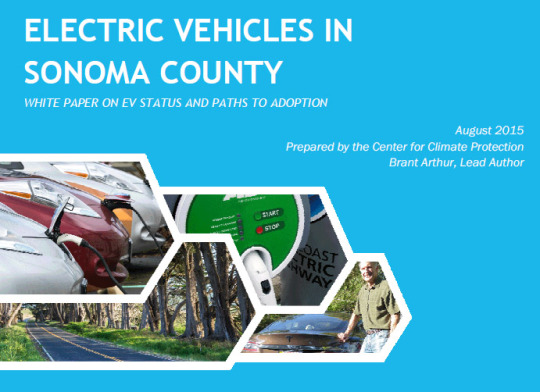Press Release, The Climate Center | August 31, 2015

The Climate Center released today a
white paper assessing the status, progress, and benefits of electric vehicle
(EV) adoption in Sonoma County. The paper also provides several recommendations
to accelerate EV adoption as one of the best opportunities to reduce greenhouse
(GHG) emissions from transportation.
According to the paper, transportation is
the largest and fastest growing source of greenhouse gas (GHG) emissions in
Sonoma County, accounting for about 65 percent of total emissions in 2014.
Nearly four out of five trips in Sonoma County are made by single occupant,
fossil fuel powered automobiles. Approximately $850 million leaves the County
annually to pay for the fossil fuel that powers Sonoma County vehicles.
“This report is important because it
provides us and our partners with a path forward and some clear guidance on how
to make a major dent in our massive carbon footprint from the transportation
sector,” said Ann Hancock, Executive Director of The Climate Center.
“We believe Sonoma County can serve as a model for rapid EV adoption. We’d like
to help other communities do the same too,” she said.
Sonoma
County is already a leader in the adoption of EVs such as the Nissan Leaf and
the Chevy Volt. As of July, more than 1,800 of these quiet, climate-friendly cars
are already zooming along county roadways. That’s an increase of 300 in just
three months, which means that every 7 hours, a new EV hits the road. More than
half of all EVs in the county were sold in 2014 alone.
“The
recent pace of adoption is what’s most exciting here,” said Doron Amiran, EV
Program Manager for The Climate Center. “If Sonoma County can
apply the recommendations endorsed in this paper, we believe we’ll far exceed
the State’s goal to have what would amount to 16,000 electric cars and vans on
the road in Sonoma County by 2023. That would equate to about 10% of new cars
sold, but we believe we can and should do much better than that. And this will
be great news for the climate, our economy, and local drivers.”
EVs emit zero carbon. However, depending
upon where the electricity to charge those vehicles is sourced, EVs still carry
a carbon footprint that ranges in size. Because Sonoma Clean Power (SCP)
sources electricity locally from a higher portfolio of renewable sources, the
environmental benefits of EV driving in Sonoma County are even greater.
Furthermore, charging those vehicles with EverGreen, SCP’s 100 percent green
electricity option, further reduces greenhouse gases.
Driving
EVs also makes economic sense. According to the paper, electric vehicle costs
are competitive with the life cycle costs of gasoline vehicles, and in some
cases are lower. “It costs me only about half as much to run my Leaf as it
would a gas-powered Prius" said Carl Mears, climate scientist and board member
for The Climate Center. “And besides, it’s the quickest car
I’ve ever owned.”
The
paper also states that EV driving is significantly enhanced by workplace
charging. Employees who have access to workplace charging are 20 times more
likely to drive an EV compared with employees who do not have access to
workplace charging. Nearly half of all Leaf and Volt owners have access to
workplace chargers.
“Labcon
installed two double outlet, solar-powered, EV charging stations in 2013 and
has seen a very positive response from both employees and visitors,” said Mark Gmelin,
Engineer and Sustainability Coordinator at Labcon North America. “We’ve gone
from one to three full-time EV drivers plus one part-timer in the first year.
Guests are happy to see a visible affirmation of our environmental commitments
as they enter the building. It’s part of our ‘do the right thing’ attitude.”
The
white paper advances four recommendations: 1) Advocate for policies and
funding, especially at the state level, to accelerate EV use, 2) Expand EV
charging, especially at workplaces, multi-family units, and along main
transportation corridors, 3) Develop and implement an EV awareness campaign, 4)
Develop EV charging infrastructure through increased coordination.
“We
look forward to working with the community, government, and business leaders to
accelerate this transition,” said Hancock. “With battery prices dropping, infrastructure
expanding, new and exciting vehicles coming to market, and a wicked zoom
factor, there is hardly a reason not to make your next purchase an EV.”
Read
The Climate Center’s complete EV white paper online at: http://staging-theclimatecenter.org/electric-vehicles-in-sonoma-county/.